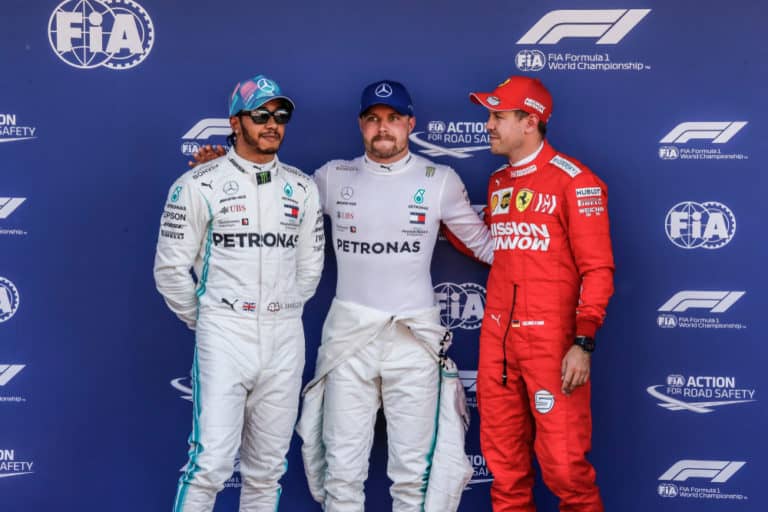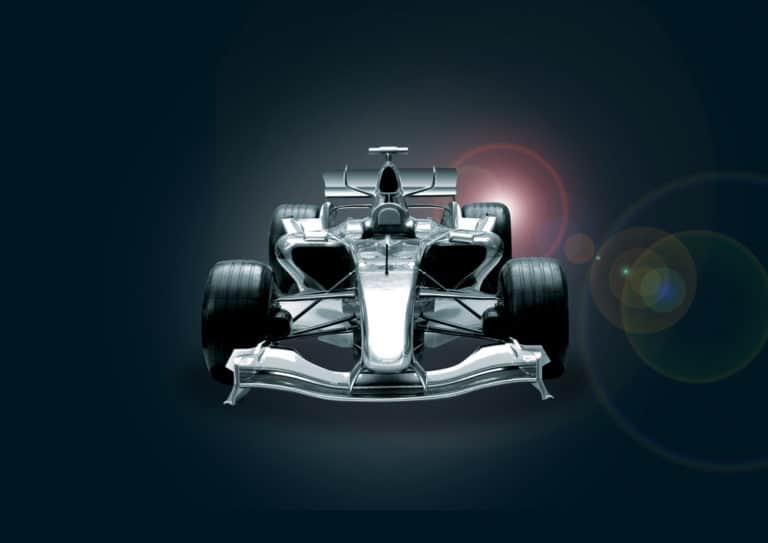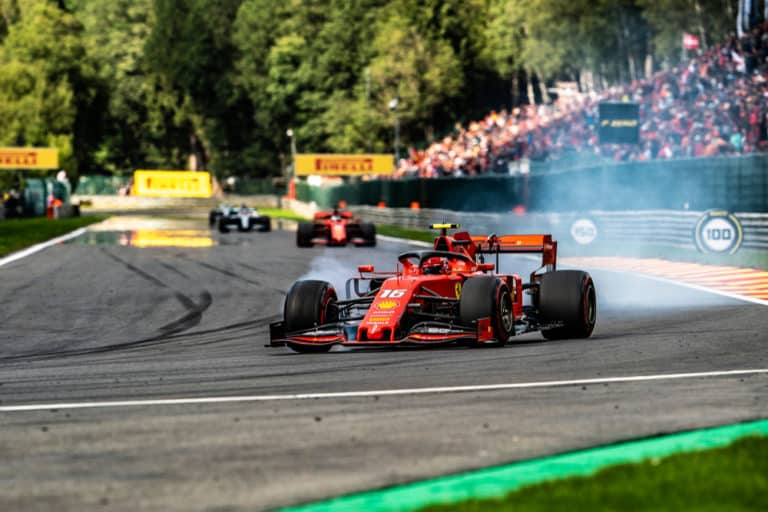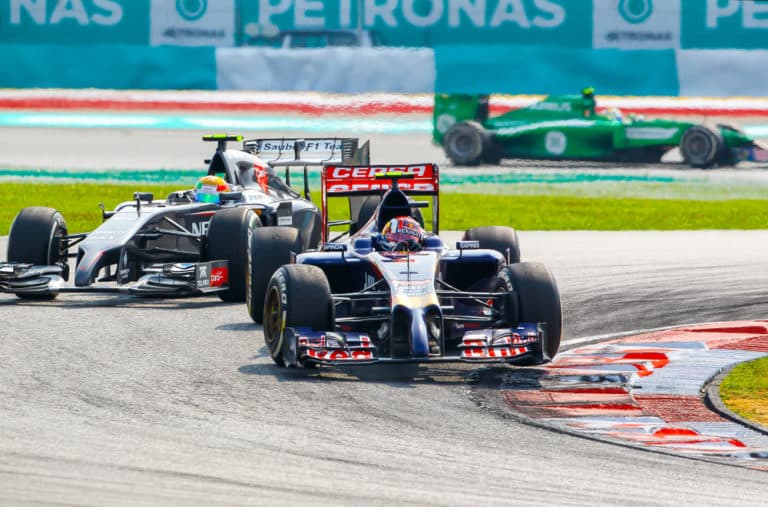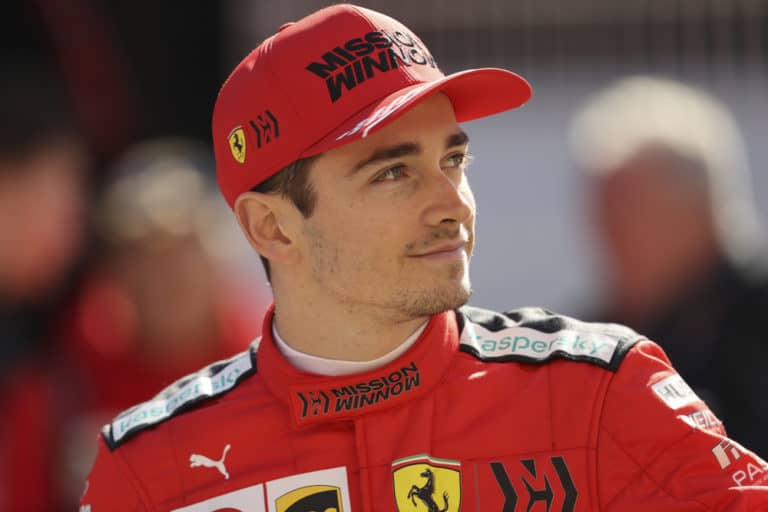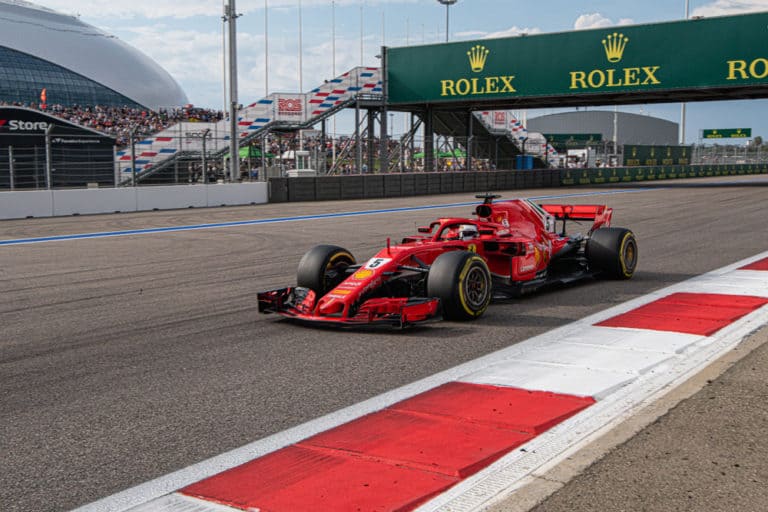In a recent article, we reviewed the best European F1 races to attend. We discussed the characteristics of some circuits and how they all have differentiating elements that make them unique and special.
Whether due to its location, tradition, or the atmosphere during that race weekend, there are circuits on the calendar that stand out for drivers and fans.
But if there is one thing that influences the racing and the spectacle on the track, that is the layout. Because of their layout, some circuits tend to provide boring races, while others tend to deliver chaotic and fun races.
And what is the layout but a set of corners and straights? Today, we will review the best F1 corners, either because they are overtaking points, iconic places, because of their spectacular nature, or for any reason. Get ready!
If you’re looking for some F1 merchandise, check out the awesome stuff at the official F1 store here.
1. Eau Rouge, Spa-Francorchamps
Eau Rouge is the most famous and iconic corner in Formula 1. Turns 3, 4, and 5 of the Circuit de Spa-Francorchamps make up Eau Rouge and Raidillon, just before the long Kemmel straight. The name of Eau Rouge is for a stream that passes through that place under the track, whose water is reddish due to the high amounts of iron it contains.
It is a fast sequence of left-right-left turns with an altitude gain of around 40 meters, with drivers reaching it at 300 km per hour and fighting against 4.4Gs. Visually stunning, with the landscape of the Ardennes behind, it has always been present at Spa and is one of the drivers’ favorite corners.
Eau Rouge has claimed many victims, such as Stefan Bellof in a Porsche in 1985 or Anthoine Hubert in an F2 at the corner exit in 2019. It has caused other significant accidents, such as Alex Zanardi in 1993 or that of Ricardo Zonta in 1999.
It is true that the FIA’s commitment to improving safety, which has made Eau Rouge not so dangerous, coupled with the fact that current cars can take it at full throttle due to its width and aerodynamics, have made it not as challenging as before. But that does not detract it from its charm, and it is still a place that is quite challenging for drivers, especially at overtaking.
Here is a compilation video of some of the best overtaking at Eau Rouge in recent years. Some like Webber pass on Alonso in 2011 are simply spectacular:
Overtakes Compilation at Eau Rouge – YouTube
2. Grand Hotel Hairpin, Monaco
If before we talked about Eau Rouge, the most famous corner in F1, we move to Monaco, the most emblematic circuit in the sport’s history, representing luxury, glamor, prestige, and of course F1, and it could not be missing in this article.
Monaco has many iconic places, which we will see a few throughout this article. But without a doubt, the most famous of them is Turn 6, the 180-degree hairpin of the Gran Hotel, in which the cars take it almost stationary, an image that indeed anyone has seen, regardless of whether they are a fan of F1.
The hairpin is named after the hotel across the street, but it has had many names, such as “Station,” “Loews” and “Fairmont” Hairpin.
Cars approach it downhill from Mirabeau at around 150 km per hour and brake, reaching the minimum of 40 km/h and making it one of the slowest corners of the calendar. Drivers have to turn the steering wheel more than 180 degrees for the car to take the hairpin correctly and hit the apex perfectly and at the proper speed to exit the hairpin and accelerate downhill to take Turns 7 and 8 that lead them into the tunnel.
The walls are very close, so it is easy to miss the braking point and crash. It was easier to overtake in the past, but with the width of today’s cars, it becomes challenging. Hopefully, next season in 2022, that will change with the new cars.
3. 130 R, Suzuka
Turn 15 of the Suzuka International Racing Circuit, better known as 130 R for having a radius of 130 meters, is a super-fast left corner. Drivers take a long hill and approach it at over 315 km per hour, hitting the apex at full throttle while fighting 3.5 Gs lateral forces and rushing off it at over 300 km per hour, making it one of the fastest corners on the calendar.
You have to be precise to take this corner. Otherwise, you can end up on the wall after crashing at a very high speed. Historically, it has been a crash point in many categories. After two tremendous accidents, one of them that of Toyota driver Allan McNish in 2002, who suffered a significant crash in qualifying ending up embedded in a metal fence (came out unharmed), the 130 R was slightly redesigned to add a straighter entry.
As with Eau Rouge, these modifications and current cars have made it not as challenging as it used to be, but it is still very dangerous and exciting even today. The most memorable overtake at 130 R was then-young Fernando Alonso over Michael Schumacher in 2005, which we leave below. It could have gone very wrong, but the talents of the two drivers made it a masterpiece that few dare to imitate:
Alonso overtake Schumacher onboard 2005 Japan – YouTube
4. S do Senna, Interlagos
Interlagos is one of the most complete circuits and is loved by all. The track, the weather, and the fans make it a special GP that never disappoints. Turns 1-3, the S do Senna or Senna S, in homage to the legend Ayrton Senna, is probably the best first corner on the calendar.
Drivers approach it at over 320 km/h after the long uphill main “straight” and take the first corner, a downhill left-hand turn that yields massive understeer, followed by a fast left-right combination, crucial to a quick entry onto the track’s other straight. The first braking point is quite tricky, as you have to brake hard at the right moment to avoid going wide.
As you may have thought, it is an excellent overtaking point, making it one of the most interesting points on the circuit and where many collisions occur. Also, being the first corner, the starts at Interlagos are always very exciting and chaotic.
This was the corner in which Esteban Ocon and Max Verstappen collided during the 2018 GP, while the Dutch were leading the race and the Frenchman tried to unlap himself, which caused great controversy and a fight between both drivers after the race.
5. The Swimming Pool, Monaco
Another of Monaco’s landmarks is the Swimming Pool Chicane. In the original Monaco track layout, the cars went straight on. Still, in the early 1970s, the government of Monaco built a municipal pool, which introduced two new, highly challenging corners, particularly the entry of the first part. This famous sequence of corners tests the speed, braking, and agility of the Formula 1 car and driver.
After the left-hander Tabac, drivers approach the Swimming Pool at over 230 km/h and have to hit both apexes, all without falling below 220 km/h, and a couple of seconds later, they have to brake to pass the next chicane, which will take them to La Rascasse.
The drivers must have iron hands to overcome the Swimming Pool, as they are going at great speed and the walls are very close. It is one of the most satisfying corners to watch since it is pure poetry to see how the drivers fight against the car to take it correctly.
Watching it in slow motion is just another level as you realize how close they come to the walls, even touching them at times. Due to its difficulty, it is also a frequent crash point and the chicane that follows it.
Also, if you ever plan to attend the Monaco GP, it is one of the best spots to watch the race, as the grandstands are close to the track and an area of great action on the track.
6. Becketts, Silverstone
If you want to see an F1 car at full capacity and the limit, you have to see them at Becketts. The Maggots and Becketts complex form a sequence of five corners, one behind the other with continuous direction changes.
With the current cars, they enter at almost 310 km per hour, crushing the two first corners, to the left and the right, at more than 300 km/h. They turn left again at 280 km/h, then right at 230 km/h, and turn left again at the last corner of the complex, exiting at over 260 km/h to take the long Hangar Straight. Just brutal.
Again, as with Eau Rouge and 130 R, the improvements in handling and downforce have made this corner less imposing due to the added grip and stability, but it still requires that bravery to get it right.
It is still very challenging to take it correctly and exit with the proper speed to take the Hangar straight. Overtaking can be tricky as attempting an alternate line can cost you a lot of time, or you may even lose control of your car and end up on the gravel, wall, or against another car.
That’s what happened between Daniil Kvyat and Carlos Sainz during the first lap of the 2017 GP, in which both were fighting for position at Becketts and ended up colliding after the Russian lost control of his car. You can see the crash below:
F1 British GP 2017 (Crazy Crash) Kvyat & Sainz – YouTube
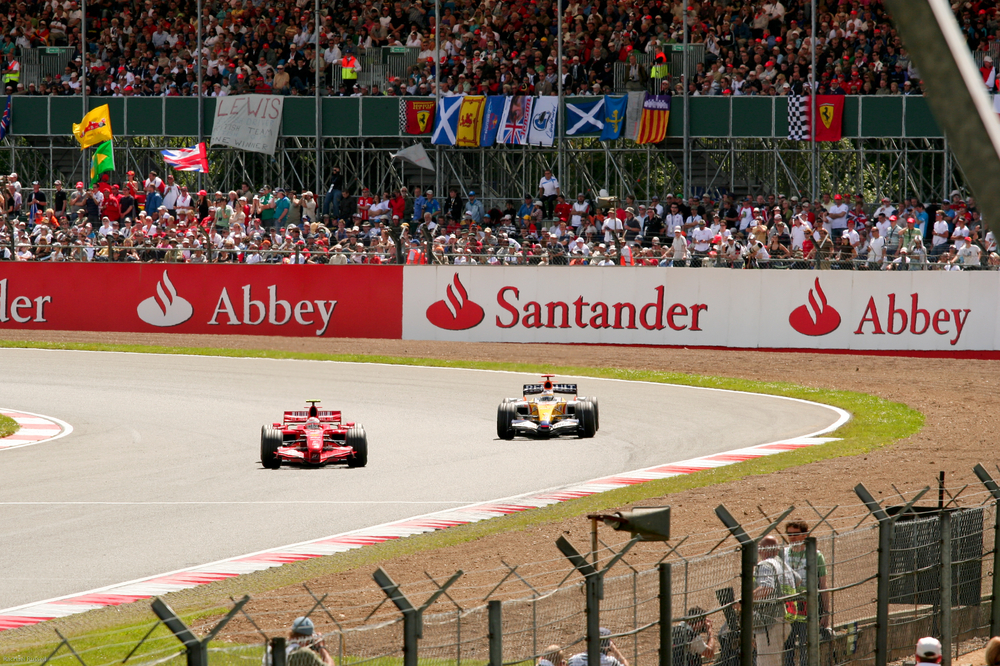
7. Curva Parabolica, Monza
Monza is the temple of speed due to its long straights in which cars can reach over 350 km/h. Its most famous corner is Turn 11, Curva Parabolica, a long 180-degree right-hand corner with an increasing radius. It gets its name after the geometry term Parabola which is the projectile’s path under the influence of gravity.
Drivers exit the Variante Ascari and take the back straight, approaching the Parabolica at over 320 km/h. Then, they brake to enter fifth gear, take the Parabolica without falling below 200 km/h, and finally exit with the proper speed to take to the long main straight.
The corner lasts about 7 seconds, so it seems eternal, and it is quite difficult to do it correctly since you have to enter it by hitting the apex and then running the car wide towards the outer part. Furthermore, Monza’s long straights demand minimum downforce trim, making this long, fast 180-degree bend extra-tricky.
That is why it is a corner where drivers make many mistakes and where there have been many accidents. This was the corner where Jochen Rindt crashed and died in 1970, becoming the first and only posthumous world champion, and where other serious accidents have occurred, such as those of Derek Warwick in 1990 or Charles Leclerc in 2020.
Because of this, the FIA introduced tarmac on the run-off area a few years ago, which penalizes errors less and was highly criticized by most fans around the world, although it is still a demanding and challenging corner.
8. Turn 8, Istanbul Park
The Turkish GP was present on the calendar between 2005 and 2011, and after 9 years of absence, it returned in 2020 as part of the new races added due to the pandemic. It was also included in the 2021 calendar, and the fans couldn’t be happier since it is a circuit that usually offers entertaining races. It certainly hasn’t let us down in either 2020 or 2021.
The Istanbul Park is a fun and fast circuit with constant ups and downs, and the most brutal corner and the one that stands out the most is undoubtedly Turn 8. Turn 8 consists of four distinct left-hander apexes with many bumps, and when it was first introduced, it seriously challenged the F1 establishment thanks to its fearsome reputation.
With current cars, drivers approach it at more than 260 km/h, and to do it correctly, they have to hit all four apexes, all without falling from 255 km/h. They exit the sequence of corners at over 270 km/h to tackle a long straight. The corner lasts more than 7 seconds as the drivers pull up to 5Gs of lateral force, making it one of the most brutal corners on the calendar.
With the grip of today’s cars, it is not as challenging as before, but it still requires a lot of bravery, mainly due to the bumpy surface, as it is very easy to get it wrong.
9. Pohon, Spa-Francorchamps
Another of Spa’s many iconic spots is Pouhon. On the etymological level, Pouhon is a ferruginous mineral spring that has given Spa its repute. The word means the place where the water springs from.
On the track, Pouhon is a great challenge to set a fast lap and bears a certain resemblance to Turn 8 at Istanbul Park. Pouhon is a double left-hand corner after a straight line of descent and is negotiated at dizzying speeds. Drivers approach it downhill at over 300 km/h and must hit both apexes to exit correctly at almost 300 km/h again.
The corner lasts about 5.5 seconds, and at no time do they drop below 280 km/h, making it a very fast corner where large lateral forces are reached. It requires total commitment as the driver flings the car in left and powers past the scenic Ardennes Forest.
As we’ve seen in many of the corners on this list, the aerodynamic advances and increased grip of today’s cars make it less challenging.
Furthermore, an insulting amount of run-off area has reduced the importance of nailing this quality corner, as mistakes are not all that crucial. Still, Pouhon itself remains an epic, traditional F1 challenge.
10. Turns 11 & 12, Albert Park
The Australian GP has not been held since 2019 due to the country’s strict sanitary measures since the start of the pandemic, but in 2022 it will be back on the calendar, so this is great news for everyone. Melbourne’s Albert Park street circuit is very fast, and the layout is quite smooth in all its sections. Of all its corners, the best for us is undoubtedly the fast chicane formed by Turns 11 and 12.
Drivers approach it at over 280 km/h after a “straight.” Just a dash of brakes is needed before flicking the car into this super-quick left-hander, followed by a quick flick back to the right as drivers attack this chicane. They exit the chicane at more than 250 km/h to tackle one of the longest straights on the track, essential for setting a good lap time.
This is one of the corners where the capability of an F1 car shows, as it is impressive how fast they take this chicane in such a steady way. Due to this, it is one of the best places to see the race if you attend the Grand Prix and the walls are very close, so you will be able to see the cars in this section a few meters from you.
11. Castle Section, Baku
The Baku City Street Circuit is one of the most challenging on the calendar, as it is very fast and the walls are very close. Since the first GP in 2016, it has usually offered chaotic and entertaining races. The toughest challenge is Turn 8, the infamous narrow Castle Section.
If the walls are close throughout the circuit, there is almost no room for a single car on this corner, and it is a place where many accidents occur. Drivers approach it at a shy 200 km/h, brake and turn left and then head uphill to the next corner. The tricky thing is to place the car in such a small space, which is why many drivers end up in the barrier, like Charles Leclerc during qualifying in 2019 when he was trying to set a good lap and said, “I’m stupid.”
The raised inside curb was removed from the inside of the corner for the 2021 GP, leaving a flatter entry and new asphalt profiling, which has made a smoother surface for drivers and slightly less dangerous. It is undoubtedly one of the most difficult corners to take on the calendar.
Conclusion
F1 races on some of the best tracks on the planet, each with amazing and individual characteristics. Many of these circuits have iconic corners, either because of the way they are or because of famous events.
In this article, we have seen some of the most famous and those that we consider the best. I encourage you to see the onboards of many of them, as some are quite impressive.
Sources
- Ranking the 7 Best Corners in Formula One | Bleacher Report | Latest News, Videos and Highlights
- The 10 Most Scintillating Corners of F1 – Part Two (intentsgp.com)
- Why Turn 8 is the greatest corner in F1… : formula1 (reddit.com)
- Top ten… Corners in Formula 1 · RaceFans
- http://www.f1-grandprix.com/?page_id=26251
- How Did Monaco’s Famous Corners Get Their Names? – YouTube
- The corners of the Spa-Francorchamps Circuit | Circuit of Spa-Francorchamps
- Changes made to infamous narrow castle section at Turn 8 | 2021 Azerbaijan GP (scuderiafans.com)

